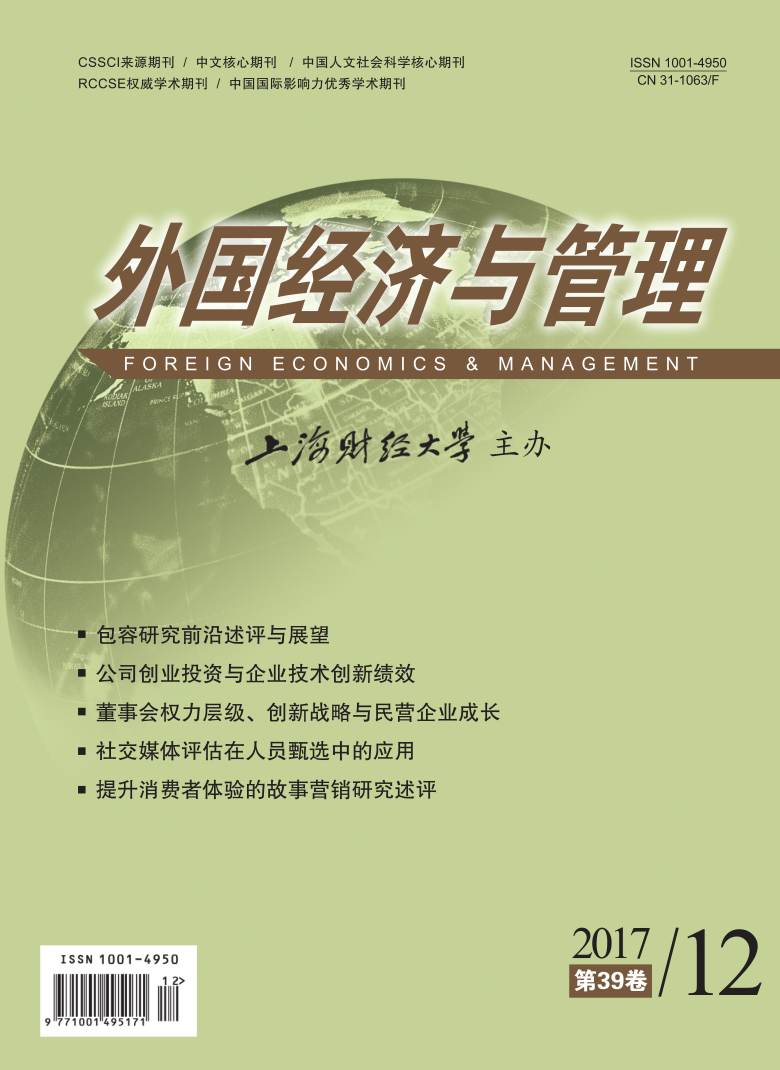层级以多种形态普遍存在于各种团体和组织中,然而现有研究却很少关注董事会团队的层级结构。在我国“关系本位”与“权威服从”的社会文化背景下,权力层级导致的个体互动差异对团队的影响尤为突出。本研究基于组织层级理论和高层梯队理论,采用非线性中介检验方法,以2011—2015年我国民营上市公司的数据为样本,探索董事会权力层级通过创新战略对民营企业成长的影响。结果发现,董事会正式权力层级会促进民营企业创新战略,而非正式权力层级会阻碍创新战略,正式权力层级与非正式权力层级之间存在替代作用;创新战略对民营企业成长产生先抑制后促进的影响;创新战略在董事会权力层级与企业成长之间存在非线性中介作用。研究结论对于民营企业优化董事会权力层级结构、实现可持续发展与高质量成长具有较为重要的实践价值。
董事会权力层级、创新战略与民营企业成长
摘要
参考文献
1 丁宇, 王卫江, 李文胜, 等. 创新型企业文化对企业成长的影响: 战略能力的中介作用——以新疆科技型中小企业为例[J]. 科技与经济, 2015,(2): 31–35.
3 李长娥, 谢永珍. 产品市场竞争、董事会异质性对技术创新的影响——来自民营上市公司的经验证据[J]. 华东经济管理, 2016b,(8): 115–123.
4 李洪亚. R&D、企业规模与成长关系研究——基于中国制造业企业数据: 2005—2007[J]. 世界经济文汇, 2014,(3): 98–120.
5 李小青. 董事会认知异质性对企业价值影响研究——基于创新战略中介作用的视角[J]. 经济与管理研究, 2012,(8): 14–22.
6 毛新述. 高管团队及其权力分布研究: 文献回顾与未来展望[J]. 财务研究, 2016,(2): 52–60.
7 邵毅平, 王引晟. 董事会资本与企业绩效的实证研究——基于R&D投资的中介效应视角[J]. 财经论丛, 2015,(6): 66–74.
9 武立东, 江津, 王凯. 董事会成员地位差异、环境不确定性与企业投资行为[J]. 管理科学, 2016,(2): 52–65.
11 谢永珍. 公司治理2.0时代: 董事会的挑战与创新[J]. 董事会, 2015,(11): 40–44.
13 张会荣, 张玉明. 技术创新、股权结构与中小企业成长[J]. 山东社会科学, 2014,(2): 114–119.
14 张耀伟, 陈世山, 李维安. 董事会非正式层级的绩效效应及其影响机制研究[J]. 管理科学, 2015,(1): 1–17.
15 Anderson C, Brown C E. The functions and dysfunctions of hierarchy[J]. Research in Organizational Behavior, 2010, 30: 55–89. DOI:10.1016/j.riob.2010.08.002
16 Birkinshaw J, Nobel R, Ridderstråle J. Knowledge as acontingency variable: Do the characteristics of knowledge predict organization structure?[J]. Organization Science, 2002, 13(3): 274–289. DOI:10.1287/orsc.13.3.274.2778
17 Diefenbach T, Sillince J A A. Formal and Informal hierarchy in different types of organization[J]. Organization Studies, 2011, 32(11): 1515–1537. DOI:10.1177/0170840611421254
18 Finkelstein S, Hambrick D C, CannellaJrA A. Strategic leadership: Theory and research on executives, top management teams, and boards[M]. Oxford: Oxford University Press, 2009: 227–254.
19 Finkelstein S, Mooney A C. Not the usual suspects: How to use board process to make boards better[J]. Academy of Management Executive, 2003, 17(2): 101–113. DOI:10.5465/AME.2003.10025204
20 Forbes D P, Milliken F J. Cognition and corporate governance: Understanding boards of directors as strategic decision-making groups[J]. Academy of Management Review, 1999, 24(3): 489–505.
21 Groysberg B, Lee L E. Hiring stars and their colleagues: Exploration and exploitation in professional service firms[J]. Organization Science, 2009, 20(4): 740–758. DOI:10.1287/orsc.1090.0430
22 Hambrick D C. Environment, strategy, and power within top management teams[J]. Administrative Science Quarterly, 1981, 26(2): 253–275. DOI:10.2307/2392472
23 Hambrick D C, Mason P A. Upper echelons: The organization as a reflection of its top managers[J]. Academy of Management Review, 1984, 9(2): 193–206.
24 Hambrick D C. Upper echelons theory: An update[J]. Academy of Management Review, 2007, 32(2): 334–343. DOI:10.5465/AMR.2007.24345254
25 Harrison D A, Klein K J. What’s the difference?Diversity constructs as separation, variety, or disparity in organizations[J]. Academy of Management Review, 2007, 32(4): 1199–1228. DOI:10.5465/AMR.2007.26586096
26 Hayes A F, Preacher K J. Quantifying and testing indirect effects in simple mediation models when the constituent paths are nonlinear[J]. Multivariate Behavioral Research, 2010, 45(4): 627–660. DOI:10.1080/00273171.2010.498290
27 He J Y, Huang Z. Board informal hierarchy and firm financial performance: Exploring a tacit structure guiding boardroom interactions[J]. Academy of Management Journal, 2011, 54(6): 1119–1139. DOI:10.5465/amj.2009.0824
28 Hendry K, Kiel G C. The role of the board in firm strategy: Integrating agency and organisational control perspectives[J]. Corporate Governance: An International Review, 2004, 12(4): 500–520. DOI:10.1111/corg.2004.12.issue-4
30 Magee J C, Galinsky A D. Social hierarchy: The self-reinforcing nature of power and status[J]. The Academy of Management Annals, 2008, 2(1): 351–398. DOI:10.1080/19416520802211628
31 Miller T, Del Carmen Triana M. Demographic diversity in the boardroom: Mediators of the board diversity–firm performance relationship[J]. Journal of Management Studies, 2009, 46(5): 755–784. DOI:10.1111/joms.2009.46.issue-5
32 Neuberg S L, Newsom J T. Personal need for structure: Individual differences in the desire for simple structure[J]. Journal of Personality and Social Psychology, 1993, 65(1): 113–131. DOI:10.1037/0022-3514.65.1.113
33 Pettigrew A M. On studying managerial elites[J]. Strategic Management Journal, 1992, 13(S2): 163–182. DOI:10.1002/(ISSN)1097-0266
34 Post C, Byron K. Women on boards and firm financial performance: A meta-analysis[J]. Academy of Management Journal, 2015, 58(5): 1546–1571. DOI:10.5465/amj.2013.0319
35 Smith A, Houghton S M, Hood J N, et al. Power relationships among top managers: Does top management team power distribution matter for organizational performance?[J]. Journal of Business Research, 2006, 59(5): 622–629. DOI:10.1016/j.jbusres.2005.10.012
36 Smith K G, Smith K A, Olian J D, et al. Top management team demography and process: The role of social integration and communication[J]. Administrative Science Quarterly, 1994, 39(3): 412–438. DOI:10.2307/2393297
引用本文
李长娥, 谢永珍. 董事会权力层级、创新战略与民营企业成长[J]. 外国经济与管理, 2017, 39(12): 70–83.
导出参考文献,格式为:
上一篇:提升消费者体验的故事营销研究述评
下一篇:社交媒体评估在人员甄选中的应用





 , 2
, 2 12970
12970  9065
9065

